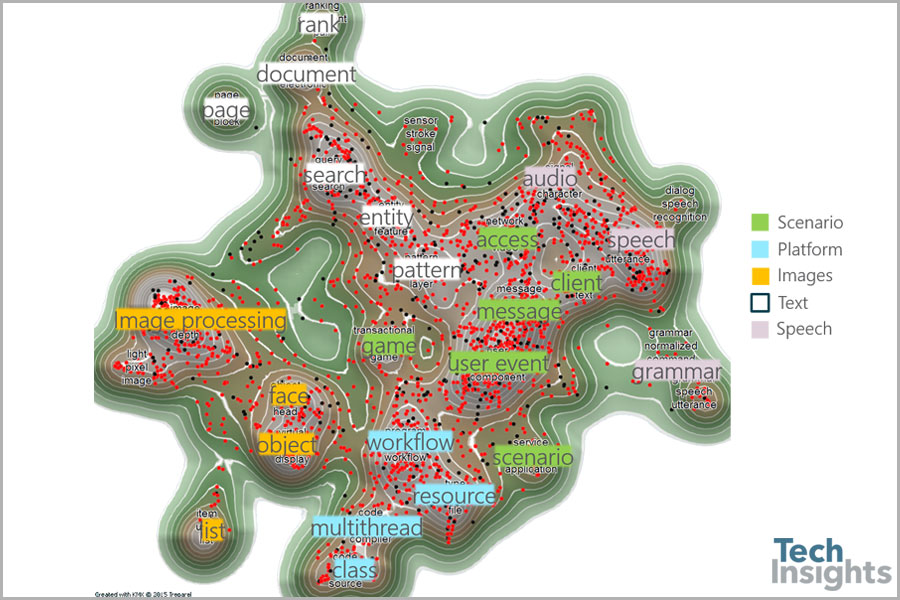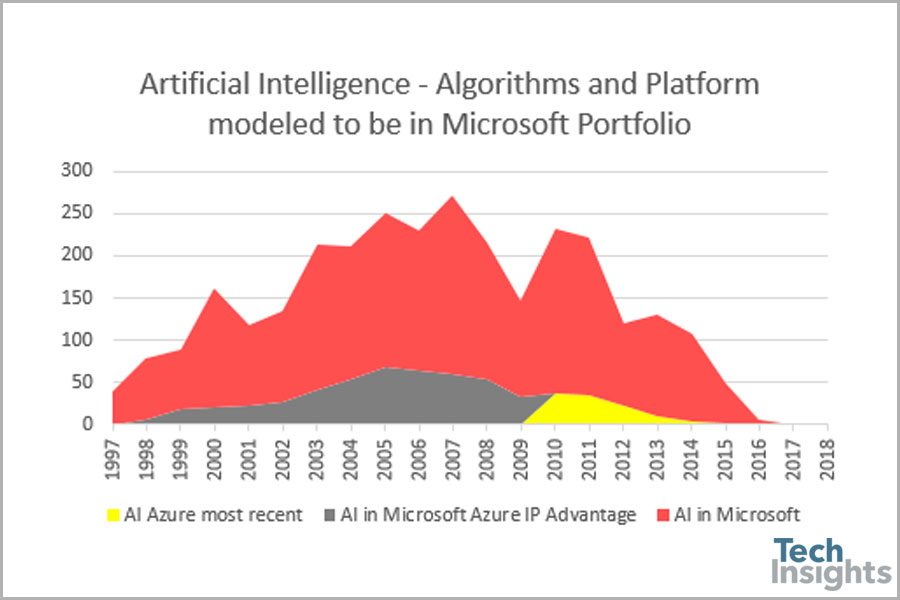Posted: February 7, 2018
Contributing Authors: Dirk Caspary, David Olaogbebikan and Martin Bijman
It has been a year since Microsoft released the Azure IP Advantage program – a service that “provides the industry’s most comprehensive protection against intellectual property (IP) risks” by making 10,000 of their global patents available to Azure clients.
A lot can happen in a year. With the pace of change in high tech, you may be wondering how well Azure IP Advantage has weathered in areas of major technological development since the portfolio was introduced.
One of the most rapidly expanding and evolving areas of high tech is artificial intelligence (AI). We set out to answer the following:
- How much of the Azure IP Advantage portfolio includes AI patents?
- Is the AI in Azure IP Advantage representative of the full Microsoft portfolio?
- Could the AI patents in Azure IP Advantage provide IP protection?
Here’s the story of our evaluation.
Azure IP Advantage Portfolio Evolution in General
First, let’s look at how different the Azure IP Advantage portfolio looks now from when it was first introduced. Is Microsoft continually updating Azure IP Advantage content to reflect market trends? Or did they future-proof it from the outset to emphasize stability?
TechInsights provided an analysis of the 10,000 patents in Azure IP Advantage in July 2017, and found it to be representative of the full breadth and strength of Microsoft’s entire portfolio. Since then, Azure IP Advantage was extended to China in September 2017, and extended to Azure Stack clients in January 2018. A comparison of the portfolio as it stood in July and as it stands now shows that it has remained very stable, with only 0.75% of the patents being adjusted (to add several more European assets to the mix, for example).
Our Definition of “Artificial Intelligence” in Azure IP Advantage
The term “artificial intelligence” has become as ubiquitous – and remained as nebulous – as “Internet of Things” (IoT) and “cloud technologies,” so the first thing we did was define AI for the purposes of our study.
Generally, there are three flavours of AI:
- Algorithms – code strings that define the behaviour of AI
- Platforms – operating systems that support the execution of those code strings
- Usage Scenarios – devices, programs, and applications that make use of algorithms and platforms to deliver AI functionality
The third – usage scenarios – represents an almost limitless range of devices and technologies, so our analysis of Azure IP Advantage tends to focus instead on the algorithms and platforms that support the delivery of AI capabilities.
How much of the Azure IP Advantage portfolio includes AI patents?
With our definition of AI established, we had to determine which patents to examine, and how to frame our research.
AI in the Microsoft patent portfolio
We found that approximately 9.4% of the US Microsoft portfolio includes AI patents that fit our model.
The criteria we applied to determine how much AI is included in Microsoft’s portfolio were:
- US patents - including grants, excluding applications
- Held by Microsoft and its subsidiaries – to include AI innovations like Skype’s real-time translation capabilities
- Containing AI phrases – we pulled together a set of 268 different phrases related to algorithms and platforms. We initially also included CPCs in our search filter, but found that it produced a data set that was too narrowly defined.

Figure 1: Different areas of AI that are observed in Microsoft US patents
Figure 1 shows the landscape of Microsoft’s US AI patents that resulted from the filters we applied.
The legend shows the different areas of AI that were included in our results. You will notice that some Usage Scenario patents leaked in to the data set, though our search criteria steered away from them. We wanted to ensure that the patents that did fit our criteria were not falsely eliminated from our data set because their innovations may use similar phrases to those in usage scenarios, so we did not actively suppress results that included some component of usage.

Figure 2: The AI patents in Azure IP Advantage are representative of the AI in Microsoft's US portfolio
AI in the Azure IP Advantage patent portfolio
With the search criteria we applied, we found that the Azure IP Advantage portfolio includes 576 AI US patents plus their corresponding family members. Furthermore, the AI patents in Azure IP Advantage portfolio are representative of the different areas covered by Microsoft’s US AI patents overall.
We applied the same AI phrase filter to the US patents in the Azure IP Advantage portfolio as we did to the overall Microsoft US portfolio. We overlaid the landscape of the US Azure IP Advantage AI patents (black dots) against the backdrop of all US Microsoft’s AI patents (red dots), as shown in Figure 2:
| Patents in Azure IP Advantage portfolio | 10,012 |
| US patents in Azure IP Advantage | 5,332 |
| US AI patents in Azure IP Advantage | 576 |

Figure 3: We inspected the newest AI innovations in the Azure IP Advantage portfolio
Could the AI patents in Azure IP Advantage provide IP protection?
Having patents is one thing, having good patents can be something entirely different. As much as patent search and filter tools can provide us with a list of patents that likely fit into specific buckets, the tools cannot offer the same levels of comprehension as an experienced expert.
We had to read some patents.
To whittle down the list from 576 to something more manageable, we wanted to find the newest patents. In the AI space, articles indicate that innovations are being productized very quickly, so we looked at the most recent innovations within the Azure IP Advantage AI portfolio subset. We selected 111 of these patents with the most recent priority dates for a quick read-through.
Figure 3 shows:
- AI patents in Microsoft’s portfolio in red
- AI patents in the Azure IP Advantage portfolio in grey
- AI patents in the Azure IP Advantage portfolio that we read in yellow
In TechInsights’ view, the Microsoft Azure IP Advantage portfolio includes many quality AI patents that will offer customers protection in this emerging market.
We did a quick inspection of the 111 patents, both to verify that the filter criteria we had applied did, in fact, find AI patents, and to get a feel for whether the innovations therein might be used. For the most part, we assumed that detection of the innovation would present a range of challenges that are associated with implementations in software, which is very likely applicable to AI.
We found that all of the patents we inspected were about improvements that are supported by AI in some way.
Our second observation was that roughly half of the patents we inspected included some facet of self-learning, which is an important feature of AI. These self-learning patents were split into two camps: claims with specific improvements in the algorithm (these patents might be used); and claims that were less limited by the algorithm (as such we expect these would be more likely to be used).




